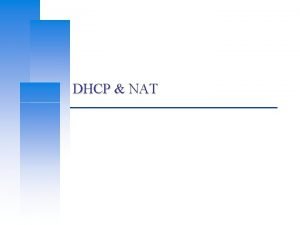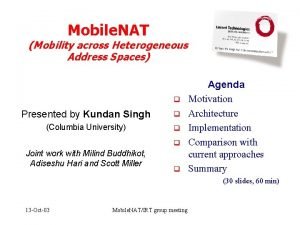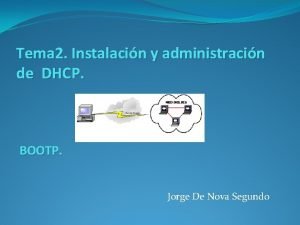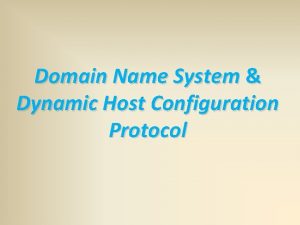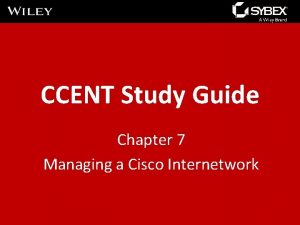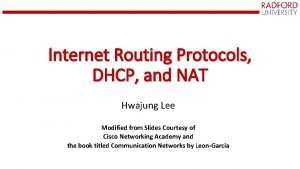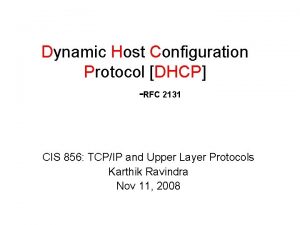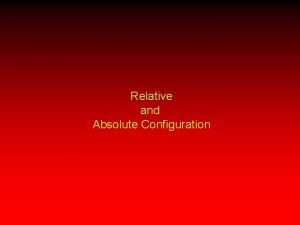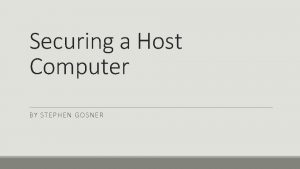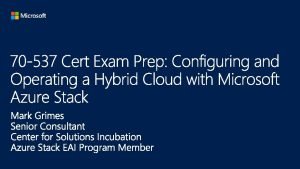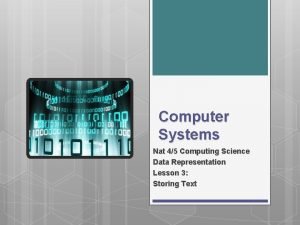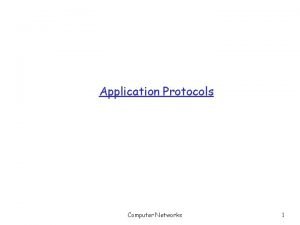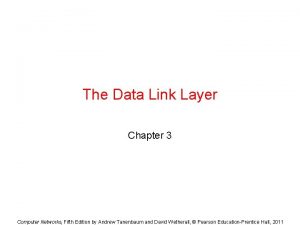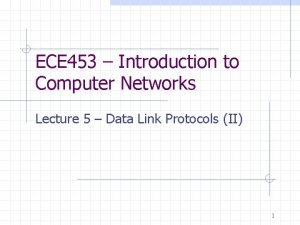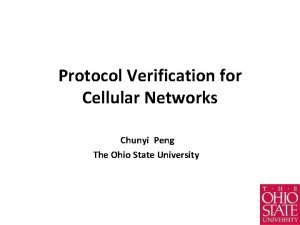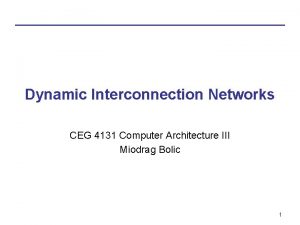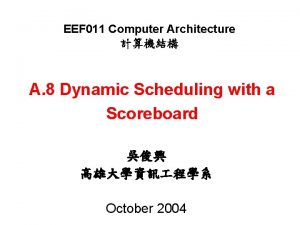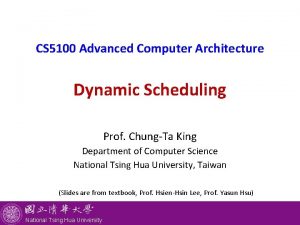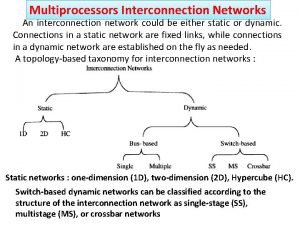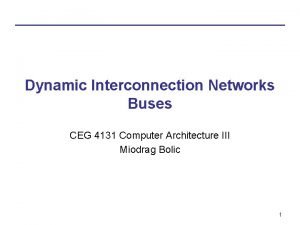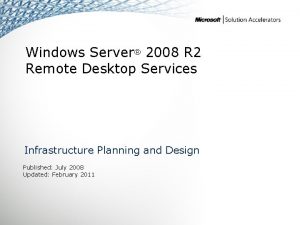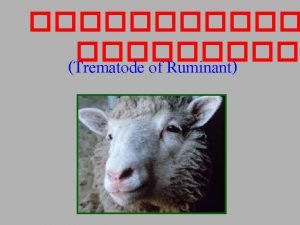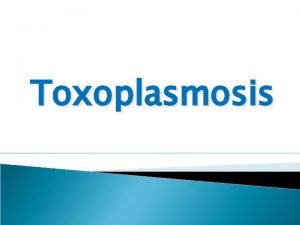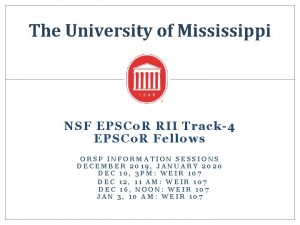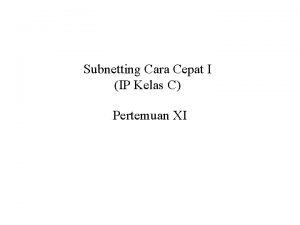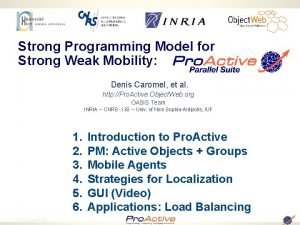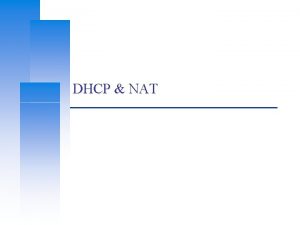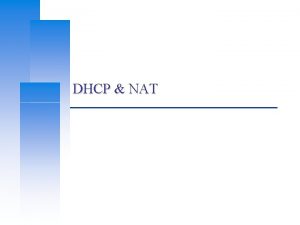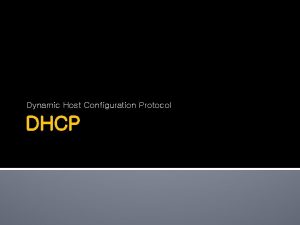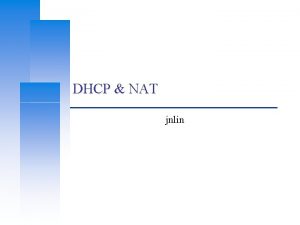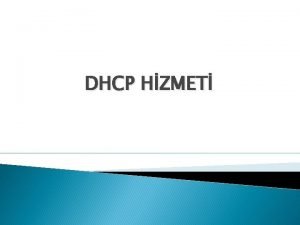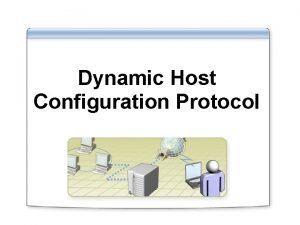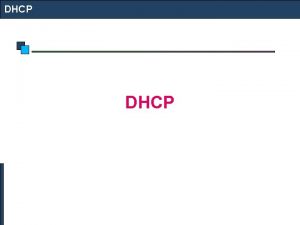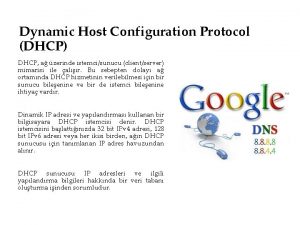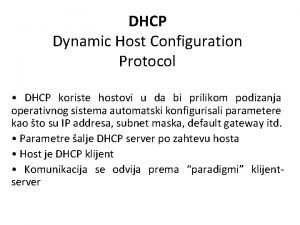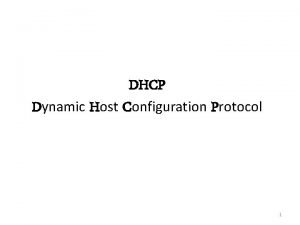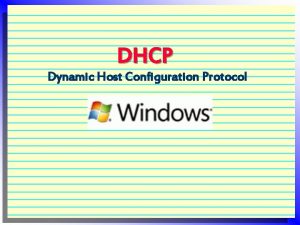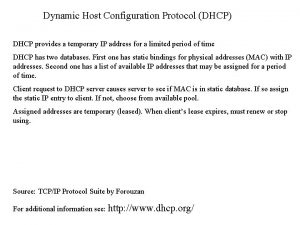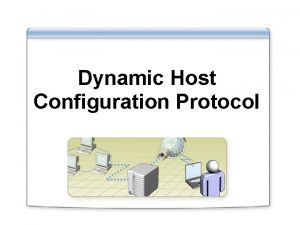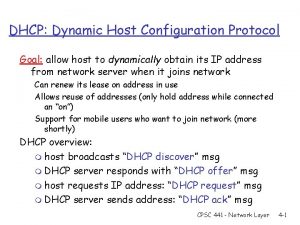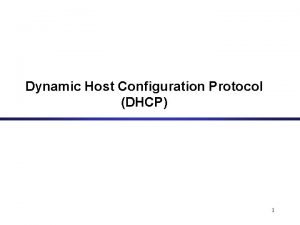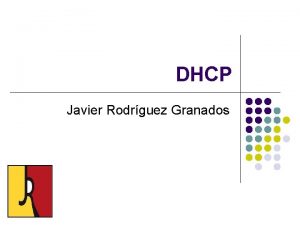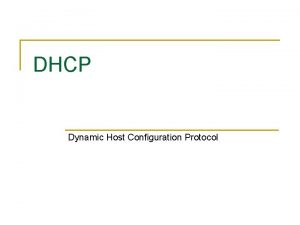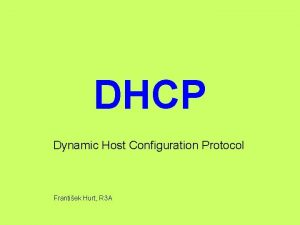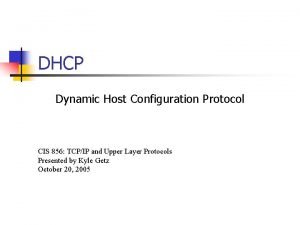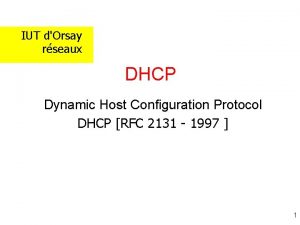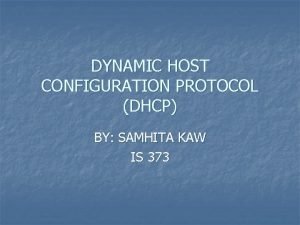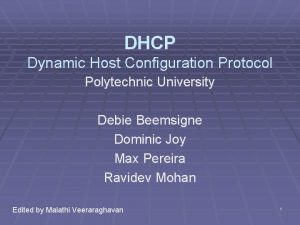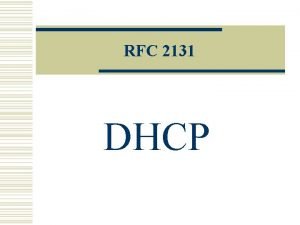DHCP NAT DHCP Dynamic Host Configuration Protocol Computer





































- Slides: 37

DHCP & NAT

DHCP – Dynamic Host Configuration Protocol

Computer Center, CS, NCTU DHCP Motivation q BOOTP • Support sending extra information beyond an IP address to a client to enable customized configuration • Effectively solve one of the major problems that administrators have with manual configuration q Problems of BOOTP • BOOTP normally uses a static method of determining what IP address to assign to a device q Dynamic Host Configuration Protocol (DHCP) • DHCP is an extension of the BOOTP. The first word describe the most important new capability added to BOOTP Ø Assign IP dynamically Ø Move away from static, permanent IP address assignment • Compatible with BOOTP 3

Computer Center, CS, NCTU DHCP introduction q DHCP • Dynamic address assignment Ø A pool of IP address is used to dynamically allocate addresses Ø Still support static mapping of addresses • Enable a DHCP client to “lease” a variety of network parameters Ø IP, netmask Ø Default router, DNS servers Ø A system can connect to a network and obtain the necessary information dynamically q Client-Server architecture • DHCP client broadcasts request for configuration info. Ø UDP port 68 • DHCP server reply on UDP port 67, including Ø IP, netmask, DNS, router, IP lease time, etc. q RFC • RFC 2131 – Dynamic Host Configuration Protocol • RFC 2132 – DHCP Options q Two main function of DHCP • • 4 Provide a mechanism for assigning addresses A method by which clients can request addresses and other configurations

Computer Center, CS, NCTU DHCP Address Assignment q Address allocation mechanisms • Provide flexibility for configuring addresses on different types of clients • Three different address allocation mechanisms Ø Manual allocation – IP address is pre-allocated to a single device Ø Automatic allocation – Assign an IP address permanently to a device Ø Dynamic allocation – Assign an IP address from a pool for a limited period of time q Manual allocation • Equivalent to the method BOOTP used • For servers and routers • Administrative benefit 5

Computer Center, CS, NCTU Dynamic allocation q Benefits for dynamic allocation • Automation Ø No intervention for an administrator • Centralized management Ø An administrator can easily look to see which devices are using which addresses • Address reuse and sharing • Portability and universality Ø Do NOT require DHCP server know the identify of each client Ø Support mobile devices • Conflict avoidance 6

Computer Center, CS, NCTU DHCP Leases q Dynamic address allocation is by far the most popular • Hosts are said to “lease” an address instead of “own” one q DHCP lease length policy • A trade-off between stability and allocation efficiency • The primary benefit of using long lease is that the addresses of hosts are relatively stable Ø Servers • The main drawback of using long leases is to increase the amount of time that an IP can be reused q Assigning lease length by client type • Use long lease for desktop computers • Use short lease for mobile devices q Factoring lease renewal into lease length selection 7

Computer Center, CS, NCTU 8 DHCP Lease “Life Cycle” q Life cycle • • • Allocation Reallocation Normal operation Renewal Rebinding Release

Computer Center, CS, NCTU 9 DHCP Lease Address Pools q Each DHCP server maintains a set of IP addresses • Use to allocate leases to clients Ø Most of clients are equals – A range of addresses is normally handled as a single group defined for a particular network

Computer Center, CS, NCTU DHCP Protocol (1) q DHCP Discover client • Broadcasted by client to find available server. • Client can request its last-known IP, but the server can ignore it. q DHCP Offer • Server find IP for client based on clients hardware address (MAC) q DHCP Request • Client request the IP it want to the server. q DHCP Acknowledge • Server acknowledges the client, admit him to use the requested IP. ※ Question • Why not use the IP after DHCP offer? 10 server 廣播: 我要I P DHCP Discover src: 0. 0 port: 68 dst: 255 port: 67 用 你可以 IP 1 DHCP Offer src: 192. 168. 1. 1 port: 67 dst: 255 port: 68 DHCP option IP=192. 168. 1. 100 netmask=255. 0 router=192. 168. 1. 1 dns=192. 168. 1. 1 IP lease time=1 day 請給 我IP 1 DHCP Request src: 0. 0 port: 68 dst: 255 port: 67 DHCP option IP 1 用 你 給 DHCP Ack src: 192. 168. 1. 1 port: 67 dst: 255 port: 68 DHCP option Request IP=192. 168. 1. 100 DHCP Server=192. 168. 1. 1 IP=192. 168. 1. 100 netmask=255. 0 router=192. 168. 1. 1 dns=192. 168. 1. 1 IP lease time=1 day

Computer Center, CS, NCTU 11 DHCP Protocol (2) q DHCP inform • Request more information than the server sent. • Repeat data for a particular application. Ø ex. browsers request web proxy settings from server. • It does not refresh the IP expiry time in server’s database. q DHCP Release • Client send this request to server to releases the IP, and the client will un-configure this IP. • Not mandatory.

Computer Center, CS, NCTU DHCP server on Free. BSD (1) q Kernel support device bpf pseudo-device bpf (Free. BSD 5. x↑) (Free. BSD 4. x↓) q Install DHCP server • /usr/ports/net/isc-dhcp 41 -server/ • % cd /usr/local/etc • % cp dhcpd. conf. sample dhcpd. conf q Enable DHCP server in /etc/rc. conf dhcpd_enable="YES“ dhcpd_flags="-q“ dhcpd_conf="/usr/local/etc/dhcpd. conf“ dhcpd_ifaces="“ dhcpd_withumask="022" 12

Computer Center, CS, NCTU DHCP server on Free. BSD (2) q Option definitions option domain-name "cs. nctu. edu. tw"; option domain-name-servers 140. 113. 235. 107, 140. 113. 1. 1; default-lease-time 600; max-lease-time 7200; ddns-update-style none; log-facility local 7; /etc/syslogd. conf /etc/newsyslog. conf 13

Computer Center, CS, NCTU DHCP server on Free. BSD (3) q Subnet definition subnet 192. 168. 1. 0 netmask 255. 0 { range 192. 168. 1. 101 192. 168. 1. 200; option domain-name "cs. nctu. edu. tw"; option routers 192. 168. 1. 254; option broadcast-address 192. 168. 1. 255; option domain-name-servers 140. 113. 17. 5, 140. 113. 1. 1; default-lease-time 3600; max-lease-time 21600; } q Host definition 14 host fantasia { hardware ethernet 08: 00: 07: 26: c 0: a 5; fixed-address 192. 168. 1. 30; } host deny. Client { hardware ethernet 00: 07: 95: fd: 12: 13; deny booting; }

Computer Center, CS, NCTU 15 DHCP server on Free. BSD (4) q Important files • • /usr/local/sbin/dhcpd /usr/local/etc/dhcpd. conf /var/db/dhcpd. leases (leases issued) /usr/local/etc/rc. d/isc-dhcpd

NAT – Network Address Translation

Computer Center, CS, NCTU IP address crisis q IP address crisis • Run out of class B address Ø The most desirable ones for moderately large organizations • IP address were being allocated on a FCFS Ø With no locality of reference q Solutions • Short term Ø Subnetting and CIDR (classless inter-domain routing) Ø NAT (network address translation) • Long term Ø IPv 6 17

Computer Center, CS, NCTU Network Address Translation (NAT) q Some important characteristics of how most organizations use the internet • Most hosts are client • Few hosts access the internet simultaneously • Internet communications are routed q Network Address Translation • RFC 1631, in May 1994 • A basic implementation of NAT involves Ø Using one of the private addresses for local networks Ø Assigned one or more public IP addresses • The word ‘translator’ refers to the device that implements NAT 18

Computer Center, CS, NCTU Private Address Space q Private addresses space defined by RFC 1918 • 24 -bit block (Class A) Ø 10. 0/8 • 20 -bit block (16 contiguous Class B) Ø 172. 16. 0. 0/12 ~ 172. 31. 0. 0/12 • 16 -bit block (256 contiguous Class C) Ø 192. 168. 0. 0/16 ~ 192. 168. 255. 0/16 q Operation consideration • Router should set up filters for both inbound and outbound private network traffic 19

Computer Center, CS, NCTU Network Address Translation (NAT) q What is NAT? • Network Address Translation • Re-write the source and/or destination addresses of IP packets when they pass through a router or firewall. • What can be re-written? Ø Source/destination IPs Ø Source/destination ports q What can NAT do? • • 20 Solve the IPv 4 address shortage. (the most common purpose) Kind of firewall (security) Load balancing Fail over (for service requiring high availability)

Computer Center, CS, NCTU 21 NAT Terminology

Computer Center, CS, NCTU NAT Address Mappings q Each time a NAT router encounters an IP datagram • It must translate addresses • BUT, how does it know what to translate, and what to use for the translated addresses q Translation table • Maps the inside local address to the inside global address • Also contains mappings between outside global address and outside local address for inbound translations q Two address mappings • Static mappings Ø Allow the inside host with an inside local address to always use a inside global address • Dynamic mappings Ø Allow a pool of inside global addresses to be shared by a large number of inside hosts 22

Computer Center, CS, NCTU 23 NAT Unidirectional Operation q NAT Unidirectional Operation • • Traditional/Outbound operation The original variety of NAT in RFC 1631 Ø The simplest NAT Ø The client/server request/response communication would sent from the inside to outside network

Computer Center, CS, NCTU 24 NAT Bidirectional Operation q NAT Bidirectional Operation • Two-Way/Inbound operation • A host on the outside network initiate a transaction with one on the inside q The problem with inbound NAT • NAT is inherently asymmetric Ø The outside network does not know the private addresses of the inside network Ø Hidden addresses are not routable Ø The outbound hosts DO NOT know the identity of the NAT router Ø NAT mapping table

Computer Center, CS, NCTU 25 NAT Bidirectional Operation q Two methods to resolve the hidden address problem • Static mapping • DNS Ø RFC 2694, DNS extensions to NAT q The basic process is as follows • The outside host sends a DNS request using the name of the private host • The DNS server for the internal network resolves the name into an inside local address • The inside local address is passed to NAT and used to create a dynamic mapping • DNS server sends back the name resolution with the inside global address

Computer Center, CS, NCTU 26 NAT Bidirectional Operation

Computer Center, CS, NCTU NAT Port-Based Operation q NAT Port-Based Operation • Overloaded operation • Network Address Port Translation (NAPT)/Port Address Translation (PAT) • Both traditional NAT and bidirectional NAT work by swapping inside network and outside network addresses Ø One-to-one mapping between inside local address and inside global address Ø Use dynamic address assignment to allow a large number of private hosts to share a small number of registered public addresses q Using ports to multiplex private addresses • Also translate port addresses • Allow 250 hosts on the private network to use only 20 IP address • Overloading of an inside global address 27

Computer Center, CS, NCTU 28 NAT Port-Based Operation

Computer Center, CS, NCTU 29 NAT Port-Based Operation q NAT example:

Computer Center, CS, NCTU NAT Overlapping Operation q NAT Overlapping Operation • Twice NAT Operation • The previous three versions of NAT are normally used to connect a network using private, non-routable addresses to the public internet Ø No overlap between the address spaces of the inside and outside network q Cases with overlapping private and public address blocks • Private network to private network connections • Invalid assignment of public address space to private network q Dealing with overlapping blocks by using NAT twice • Translate both the source and destination address on each transition • Rely on use of the DNS Ø Let the inside network send requests to the overlapping network in a way that can be uniquely identified 30

Computer Center, CS, NCTU 31 NAT Overlapping Operation q A client, 18. 0. 0. 18, wants to send a request to the server www. twicenat. mit. edu, 18. 1. 2. 3. • • • 18. 0. 0. 18 sends a DNS request NAT router intercepts this DNS request Ø Consult its tables to find a special mapping for this outside host NAT router returns 172. 16. 44. 55 to the source client

Computer Center, CS, NCTU NAT Compatibility Issues q It is NOT possible for NAT to be completely transparent to the hosts that use it • ICMP Manipulations • Applications that embed IP address Ø FTP • Additional issues with port translation Ø The issues applying to addresses now apply to ports as well • Problems with IPSec 32

Computer Center, CS, NCTU SNAT q SNAT & DNAT • S: Source D: Destination • SNAT Ø Rewrite the source IP and/or Port. Ø The rewritten packet looks like one sent by the NAT server. S: 192. 168. 1. 1: 1234 D: 140. 113. 235. 107: 53 192. 168. 1. 1 192. 168. 1. 254 S: 140. 113. 235. 250: 10234 D: 140. 113. 235. 107: 53 140. 113. 235. 250 NAT Mapping Table: 192. 168. 1. 1: 1234 – 140. 113. 235. 250: 10234 33 140. 113. 235. 250

Computer Center, CS, NCTU DNAT • DNAT Ø Rewrite the destination IP and/or Port. Ø The rewritten packet will be redirect to another IP address when it pass through NAT server. S: 140. 113. 24. 107: 1357 D: 192. 168. 1. 1: 80 192. 168. 1. 1 192. 168. 1. 254 S: 140. 113. 24. 107: 1357 D: 140. 113. 235. 107: 8080 140. 113. 235. 250 NAT Mapping Table: 140. 113. 235. 250: 8080 – 192. 168. 1. 1: 80 • Both SNAT and DNAT are usually used together in coordination for two-way communication. 34 140. 113. 24. 107

Computer Center, CS, NCTU NAT on Free. BSD (1) q Setup • Network topology • configuration • Advanced redirection configuration 192. 168. 1. 1 Web server 192. 168. 1. 2 Ftp Server 192. 168. 1. 101 PC 1 35

Computer Center, CS, NCTU 36 NAT on Free. BSD (2) q IP configuration (in /etc/rc. conf) ifconfig_fxp 0="inet 140. 113. 235. 4 netmask 255. 0 media autoselect" ifconfig_fxp 1="inet 192. 168. 1. 254 netmask 255. 0 media autoselect“ defaultrouter="140. 113. 235. 254“ q Enable NAT • • Here we use Packet Filter (PF) as our NAT server Configuration file: /etc/pf. conf Ø nat Ø rdr Ø binat # macro definitions extdev='fxp 0‘ intranet='192. 168. 1. 0/24‘ webserver=‘ 192. 168. 1. 1’ ftpserver=‘ 192. 168. 1. 2’ pc 1=‘ 192. 168. 1. 101’ # nat rules nat on $extdev inet from $intranet to any -> $extdev rdr on $extdev inet proto tcp to port 80 -> $webserver port 80 rdr on $extdev inet proto tcp to port 443 -> $webserver port 443 rdr on $extdev inet proto tcp to port 21 -> $ftpserver port 21

Computer Center, CS, NCTU 37 NAT on Free. BSD (3) # macro definitions extdev='fxp 0‘ intranet='192. 168. 219. 0/24‘ winxp=‘ 192. 168. 219. 1’ server_int=‘ 192. 168. 219. 2’ server_ext=‘ 140. 113. 214. 13’ # nat rules nat on $extdev inet from $intranet to any -> $extdev rdr on $extdev inet proto tcp to port 3389 -> $winxp port 3389 binat on $extdev inet from $server_int to any -> $server_ext
 Definitive host vs intermediate host
Definitive host vs intermediate host Dhcp and nat
Dhcp and nat Dhcp and nat
Dhcp and nat Bootp que es
Bootp que es Domain host control protocol
Domain host control protocol Scalance s615 nat configuration
Scalance s615 nat configuration Dhcp configuration on router
Dhcp configuration on router Dhcp routing protocol
Dhcp routing protocol Rfc shcp
Rfc shcp Failover protocol
Failover protocol What is absolute configuration
What is absolute configuration Chiral or achiral
Chiral or achiral Electron configuration vs noble gas configuration
Electron configuration vs noble gas configuration Relative configuration
Relative configuration Host computer definition
Host computer definition Register asdk azure
Register asdk azure Kyle bickel
Kyle bickel Nat computer science
Nat computer science Dynamic dynamic - bloom
Dynamic dynamic - bloom Internet transport protocol in computer networks
Internet transport protocol in computer networks Ftp protocol in computer networks
Ftp protocol in computer networks A utopian simplex protocol
A utopian simplex protocol Unrestricted simplex protocol in computer networks
Unrestricted simplex protocol in computer networks Chunyi peng
Chunyi peng Dynamic interconnection network in computer architecture
Dynamic interconnection network in computer architecture Dynamic scheduling in computer architecture
Dynamic scheduling in computer architecture Dynamic scheduling in computer architecture
Dynamic scheduling in computer architecture Static interconnection network
Static interconnection network Dynamic interconnection network in computer architecture
Dynamic interconnection network in computer architecture Remote desktop virtualization host role server 2012
Remote desktop virtualization host role server 2012 Fasciolidae
Fasciolidae Toxoplasma intermediate host
Toxoplasma intermediate host Orsp ole miss
Orsp ole miss Taenia solium
Taenia solium Freetoasthost
Freetoasthost Ip kls c
Ip kls c Weak host model
Weak host model Host-ert456
Host-ert456

